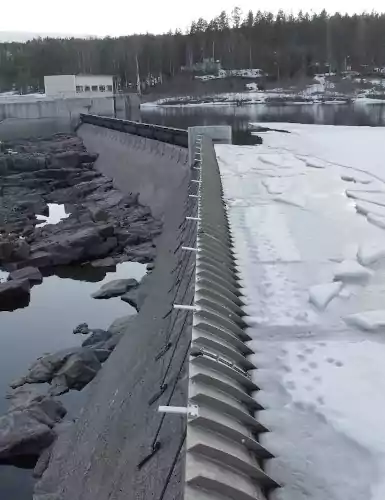The spillway gate system is most simply described as a row of steel gate panels supported on their downstream side by inflatable air bladders. By controlling the pressure in the bladders, the pond elevation maintained by the gates can be infinitely adjusted within the system control range (full inflation to full deflation) and accurately maintained at user-selected set-points.
The spillway gate system is attached to the foundation structure by anchor bolts and clamps. There are an equal number of air bladder and gate panel sets. The individual steel gate panels and air bladders are generally fabricated in widths of 3.0m or 5.0m for systems up to about 2.0m high. Higher gates use various standard width air bladders such that the height/length ratio is always less than 1.0. Each air bladder is connected to the air supply pipe.
The gaps between adjacent gate panels are spanned by reinforced EPDM rubber webs clamped to adjacent gate panel edges. At each abutment, an EPDM rubber wiper-type seal is fixed to the gate panel edge. This seal rides up and down the stainless steel abutment plate, keeping abutment plate seepage to a minimum. For installation in cold climates the abutment plates can be provided with heaters to prevent ice formation. Alternatively, UHMW polyethylene abutment plates can be used.

The Obermeyer spillway gates are custom designed to conform to any existing or desired spillway cross-section with a minimum profile when the gate is in the lowered position.
Obermeyer installed its first spillway gate in the USA in 1988 and in Europe in 1997. The highest Obermeyer spillway gate currently in operation is 6.5m high x 10.0m wide. Four such gates are installed at Lakatnik and Svragen small hydropower plants in Bulgaria. Installation was completed in 2007.
The main features of the Obermeyer spillway gate are:
Modular design means that very long spans can be installed
Single components can easily be replaced if damaged
Steel panels protect the air bladders from damage
Can be operated at any height from fully inflated to fully deflated
Can operate with higher values of overtopping; no vibration
Independent operation of different gate sections is possible